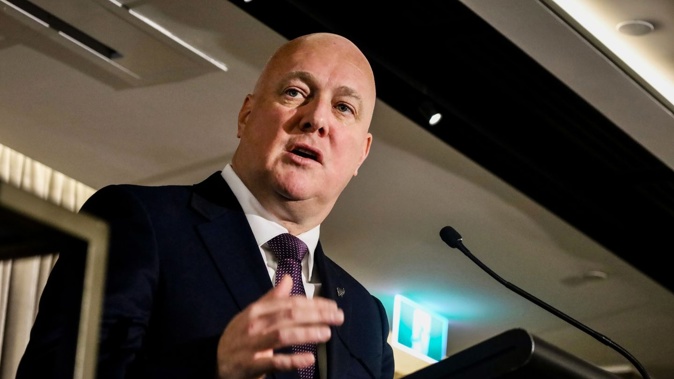
National leader Christopher Luxon is “not opposed per se” to bilingual road signs but says priority should be given to fixing potholes - even though Waka Kotahi NZ Transport Agency is only replacing signs when it becomes necessary, such as for those damaged by Cyclone Gabrielle.
Prime Minister Chris Hipkins isn’t backing down from accusing National of dog-whistling and stoking opposition to the new signs, but Hipkins himself was put to the test on translating the Māori names of government departments and our national museum.
The debate was sparked by National’s transport spokesman Simeon Brown, who this month told a Bay of Plenty meeting about transport infrastructure that “we all speak English, they should all be English” when asked for his opinion on Waka Kotahi’s proposal to introduce signs in English and te reo Māori.
“My view is it will make signs more confusing,” Brown said, telling the transport agency to just “do your job”.
The transport agency is consulting on its Tohu Huarahi Māori Bilingual Traffic Signs programme that would replace old destination signs, public and active transport signs, walking and cycling signs, general advisory and warning signs, plus motorway and expressway signs, with bilingual versions.
/cloudfront-ap-southeast-2.images.arcpublishing.com/nzme/EWCIH7ZPNVA43DDRWA7SV2OMG4.png)
The Tohu Huarahi Māori Bilingual Traffic Signs programme seeks to replace old destination signs with bilingual versions. Photo / Waka Kotahi
Existing signs would only be replaced with bilingual signs when they needed to be replaced due to damage or wear and tear.
The language used for safety-focused signs like stop or give way signs would not be changed.
Luxon said he was “not opposed per se” to bilingual signs but believed the matter was an “absolute distraction” from road maintenance.
“I would like those signs to be replaced quickly and put them up, do whatever the fastest, quickest way to do it so that people can navigate on their roads, but spend the money and make sure the focus, time and effort from everybody working at [the transport agency] and the Ministry of Transport is on actually improving our roading network.”
The Opposition leader said he was learning te reo Māori and was a “big fan”.
“I think it’s fantastic, we embrace it fully.”
/cloudfront-ap-southeast-2.images.arcpublishing.com/nzme/SQZKNMNKGVCGNMLHQ4OCRETKMA.jpg)
National transport spokesperson Simeon Brown speaking at a transport meeting this month in Bethlehem, Tauranga. Photo / Alex Cairns
Brown sought to clarify his previous comments today by saying his concern surrounded changing signs that were critical to road safety, despite those signs not being included in Waka Kotahi’s programme.
“The vast majority of New Zealanders speak English and it’s really important that those signs are quickly understandable.”
He said it would not be a priority for a future National Government but confirmed bilingual signs would not be taken down if he was Transport Minister.
National Māori Development spokesman Tama Potaka said he’d had a kōrero with Brown but was “pretty relaxed” about the matter.
Asked if the comments were racist, Potaka didn’t answer directly but said: “I heard about the comments, I read about them, we’ve had a korero and bilingual signs, I’m pretty relaxed.”
National campaign chair Chris Bishop wouldn’t confirm when asked whether he, Luxon or deputy leader Nicola Willis had spoken to Brown about his comments.
Hipkins this morning continued to push his view that if the United Kingdom and the United States had bilingual signs then New Zealand could too.
However, he ran into difficulty when asked what the translation was for Waka Kotahi, formerly known as the New Zealand Transport Agency.
“I can’t give you a direct translation for Waka Kotahi.”
According to its website, Waka means vessel and Kotahi means one - combining to promote the sentiment of “travelling together as one”.
Hipkins was also unable to provide a translation for Te Papa, New Zealand’s national museum.
Its full name, Te Papa Tongarewa, translated to “container of treasures”, according to the WellingtonNZ website.
Te reo Māori is an official language in New Zealand, alongside sign language. Curiously, English is only a de facto official language.
As an indigenous language, te reo Māori’s use was actively discouraged by successive governments following colonisation by the British for generations in favour of English, but in recent decades this position has reversed off the back of political activism from Māori, and led to a renaissance.
According to Statistics NZ, in 2021 just under 8 per cent of New Zealanders were able to speak te reo Māori at least fairly well - up from 6 per cent in 2018.
Since 2018, the proportion of people able to speak more than a few words or phrases of te reo Māori also rose - from 24 per cent to 30 per cent. This followed a previous, smaller, rise between 2016 and 2018.
Take your Radio, Podcasts and Music with you









